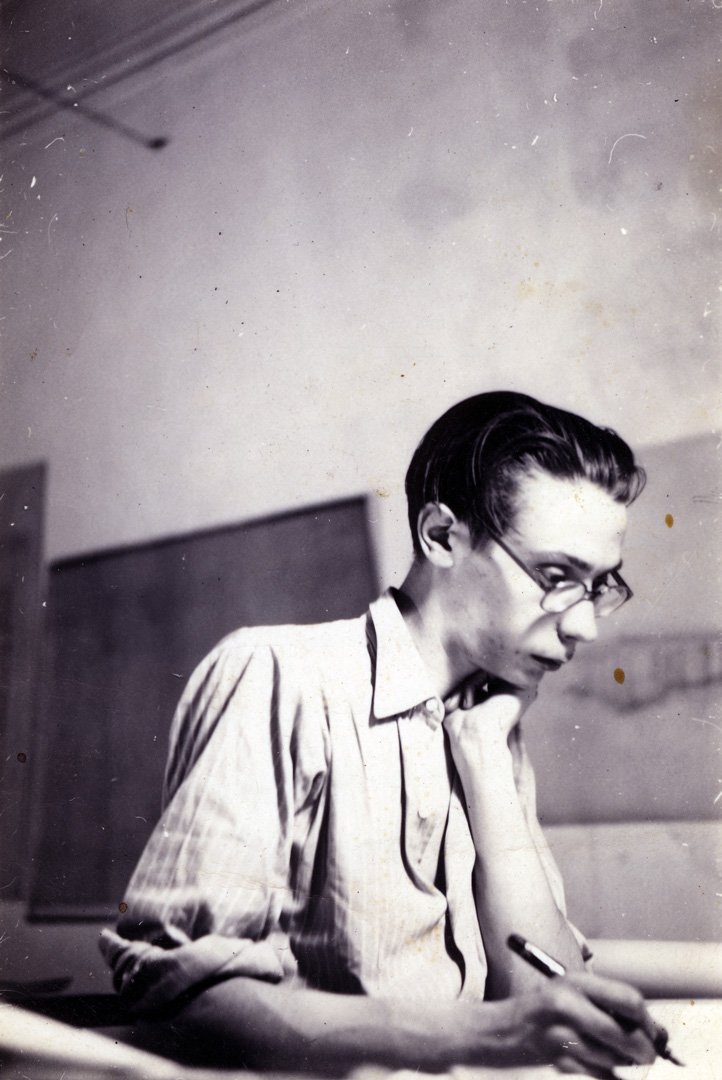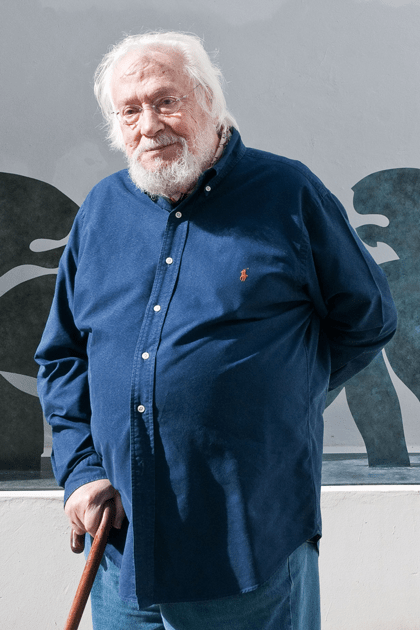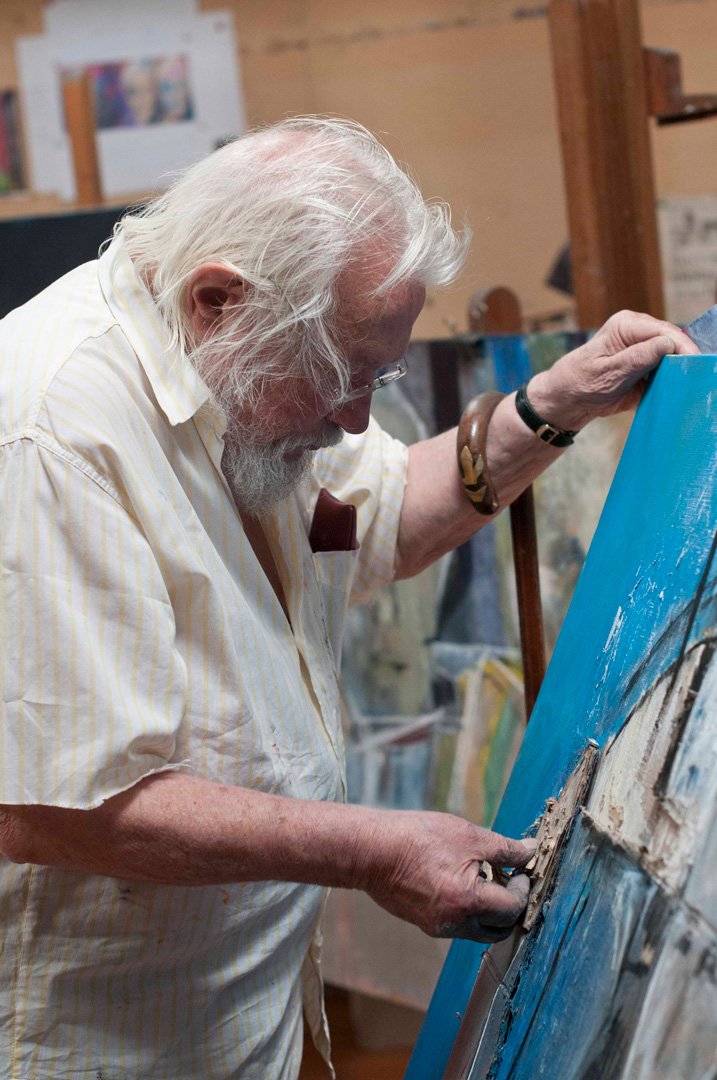Júlio Pomar was born in Lisbon in 1926. He attended the António Arroio Secondary Art School in Lisbon and the Fine Arts academies of Lisbon and Porto. In 1942 he participated in his first group show, in Lisbon. His first solo exhibition was in Porto, in 1947, where he exhibited some drawings. In these early years, his opposition to Salazar’s dictatorial regime gained him four months in prison, the confiscation of one of his paintings by the political police and the destruction of the 100 m2 mural painting he had executed for the Cinema Batalha in Porto, which was painted over. He lived in Portugal until 1963, when he moved to Paris. He lived and worked between Paris and Lisbon until he died, in May 2018, in the capital of Portugal.
From a career that has crossed eight decades, the artist highlights, after his initial period, the so called neorealist period, the exhibitions “Tauromachies” and “Les Courses” (Galerie Lacloche, Paris, 1964 and 1965); his work featured in a show dedicated to the Ingres painting Le Bain Turc, at the Louvre (1971); the series of paintings Mai 68 (CRS SS) and Le Bain Turc (Galeria 111, Lisbon); the exhibitions “L’Espace d’Eros” (Galerie de la Différence, Brussels, 1978) and “Théâtre du Corps” (Galerie de Bellechasse, Paris, 1979); “Tigres” (Galerie de Bellechasse and Galeria 111, 1981 and 1982); “Um ano de desenho – quatro poetas no Metropolitano de Lisboa” (preliminary studies for Alto dos Moinhos station) in 1984 at the Calouste Gulbenkian Modern Art Centre, which in 1978 hosted his first retrospective exhibition; “Ellipses” (Galerie de Bellechasse, Paris, 1984); and “Mascarados de Pirenópolis” (Galeria 111, ARCO, Madrid, 1988).
In the early 1990s, a sojourn in Alto Xingú in the Brazilian Amazon would result in the exhibitions Los Indios” (Galeria 111, ARCO, Madrid) and “Les Indiens” (Galerie Georges Lavrov, Paris), in 1990, followed by “Pomar/Brasil”, a survey exhibition organised by The Centro de Arte Moderna (CAM) of the Calouste Gulbenkian Foundation, which travelled to Brasilia, São Paulo, Rio de Janeiro and Lisbon. The French Ministry of Culture invited Júlio Pomar to paint a portrait of Claude Lévi-Strauss, after which he went on to paint a portrait of the Portuguese president Mário Soares for the official gallery of the Palácio de Belém (1991). Later came the exhibitions “Pomar et la Littérature” (Charleroi, Belgium, 1991), “Fables et Portraits” (Galerie Piltzer, Paris, 1994), the fictional theme of which was revisited in “O Paraíso e Outras Histórias” (Culturgest, Lisbon, 1994), and “L’Année du cochon ou les méfaits du tabac” (Galerie Piltzer, 1996). The Brazilian Amazon is again in “Les Joies de Vivre” (Galerie Piltzer, 1997) and “Les Indiens – Xingú 1988–1997” (Festival International de Biarritz). The series La Chasse au Snark was exhibited in Paris (Galerie Piltzer, 1999) and New York (Salander-O’Reilly Gallery, 2000).
He showed “Pinturas Recentes”, comprising works previously unseen in Portugal, at the Aveiro Conference Centre in 2000, and in 2002 returned to Galeria 111 with the exhibition “Os Três Efes – Fábulas, Farsas e Fintas”, followed by “Trois travaux d’Hercule et quelques chansons réalistes” and “Méridiennes –Mères Indiennes” (Galerie Patrice Trigano, Paris, 2002 and 2004); “Fables et Fictions, sculptures and photography by Gérard Castello-Lopes” (Galerie Le Violon Bleu, Sidi Bou-Said, Tunisia, 2004), which was extended in “A Razão das Coisas”, in the form of assemblages and bronzes, which were also photographed by José M. Rodrigues, Casa de Serralves, Porto (2009, followed by subsequent touring).
In 2004, Marcelin Pleynet commissioned a survey exhibition at the Sintra Museum of Modern Art – Berardo Collection, which he called “Autobiografia”, followed by “A Comédia Humana”, a retrospective exhibition of work produced by Júlio Pomar over the last few decades, curated by Hellmut Wohl and held at the Centro Cultural de Belém. In 2008, Serralves Contemporary Art Museum in Porto featured numerous previously unseen assemblages by Pomar in its show “Cadeia da Relação”, commissioned by João Fernandes. In 2009, he showed “Nouvelles aventures de Don Quixote et Trois (4) Tristes Tigres” (Galerie Patrice Trigano), followed by “Atirar a albarda ao ar” at the Cooperativa Árvore, Porto, and Galeria 111, Lisbon, in 2012–13.
In addition to his various paintings, drawings sculptures, ceramic works, prints, and so on, Júlio Pomar wrote Catch: thèmes et variations, Discours sur la cécité du peintre, …Et la peinture? (Éditions de la Différence, Paris, 1984, 1985 and 2000), the last two translated into Portuguese by Pedro Tamen under the titles Da Cegueira dos Pintores (Imprensa Nacional, 1986) and Então e a Pintura? (Dom Quixote, 2003); as well as the two poetry collections Alguns Eventos and TRATAdoDITOeFEITO (Dom Quixote, 1992 and 2003).
Júlio Pomar founded the Júlio Pomar Foundation in 2004.


